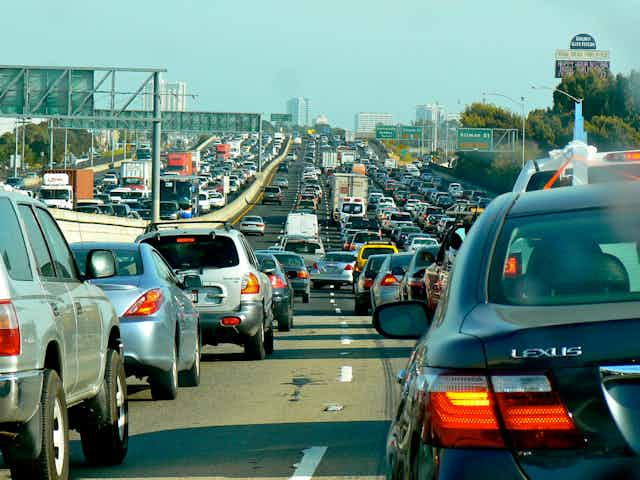Although the national budget is now apparently $12 billion in debt, a welter of state governments are pressing the federal government for support to build new freeways. The Victorian Government has just pledged its support to the $9 billion East-West Link, and has called for the federal government to chip in. Meanwhile, Sydney’s WestConnex project to extend the M4 and M5 freeways has a price somewhere in the $10—13 billion range, and they want support too.
Justifying such expenditure has seen old freeway myths dusted off and foisted again on the general public by politicians, the popular media, and road experts who ought to know better. Myths such as “freeways will reduce urban congestion” and “freeways lower greenhouse gas emissions”. Myths that congestion is a major drag on the economy and freeways will provide more amenity to the outer suburbs.
Transport research and bitter experience have long since laid these claims to rest, but somehow the evidence has been overlooked.
Myth #1: New freeways reduce congestion
Not only is this not true, but new freeways increase overall road use and contribute to worsening congestion. If you want to reduce road congestion — an understandably popular goal in our car-dependent capital cities — the only viable option is to reduce the demand for road space.
Not only does international research support this fact, local anecdotal experiences reflect it. We are living through an era of urban freeway building, yet congestion is worsening and travel times are lengthening.
Why does this happen? New roads don’t just divert existing traffic but also attract new users and keep on doing so until they reach capacity. In transport planning jargon, this is the effect of “induced traffic”. The more roads you build, the more traffic you have.
There are also associated effects that flow on from building freeways, such as land use decisions that then reinforce car use and car-dependency.
Myth #2: Faster speeds reduce fuel consumption and lower emissions
Given the problem of induced traffic within traffic systems, theoretical savings of fuel and emissions will never eventuate in practice. Cars will not go faster or drive more smoothly, and fuel will not be saved.
Of all the major climate change strategies in the world for transport, none have seriously advocated freeway construction as a way to curb vehicle emissions. Why? It would not work.
Essentially, this is a logical fallacy that assumes what holds true at the individual scale - driving more smoothly reduces emissions - holds true at the systemic scale.
Myth #3. Freeways help outer-suburban communities
If we define increased equity as giving people in the outer suburbs the right to reach CBD-bound congestion sooner, then this claim might be true.
But by any conventional definition, the inequitable access to mobility in the outer suburbs is a result of making those places car dependent. Governments have failed to provide high-quality public transport in, to and from these areas. There is little or no cycle infrastructure, and services within walking distance are rare. Addressing those problems would do far more to provide equity for the outer suburbs.
Inequitable access to education, health, and transport services, especially those needed by young families, is a major issue in our growing cities; its is difficult to see how expenditure on major freeways will meaningfully address these problems.
Myth #4: Road congestion is a drain on the economy
In debates over the value of road funding, some very high estimates of congestion costs are circulated; see, for example, the estimated $9.4 billion cost for Australia’s congestion in 2005.
On a per capita basis for the nation, this is an extraordinary amount for being delayed in traffic. So if there was no congestion, would the economy financially benefit to this extent? No, because personal travel time isn’t included as part of the GDP. So we don’t know what the net economic benefits of reduced congestion would be, but they would be considerably less than the aforementioned costs.
Even if freeway building were to reduce congestion (see myth #1), that reduced congestion would not likely add much to the economy.
To be fair, many of the reports in question recognise the limits of these types of assumptions, but their necessary caveats never seem to make in into the media coverage.
Do we really want to stop congestion anyway?
Controversially, congestion might not be the problem, but a part of the solution.
Road congestion performs a crude but effective role — it is a disincentive to road use because of the personal costs it imposes on drivers. Getting stuck in traffic jams makes us consider other ways - or times - to travel.
This kind of “demand control” of road use can also be achieved by congestion charging. You can see this in London and Singapore, where car commuters pay more if they want to drive on heavily-used roads at times when they’re popular.
If we do want to reduce congestion, this is an effective way to do it; more effective than building freeways. But toll roads, road access charging, and road congestion charging are deeply unpopular in the community and among elected politicians (how do you cut the ribbon on a congestion charge?) and are unlikely to become widespread any time soon.
Rather than investing in new freeways under the false promise that road congestion will be relieved, there is a case for letting congestion perform another task. Congestion can give us an incentive to think about other investments in transport, namely in public and active transport, as a way to effectively reduce the number of cars on our roads and provide viable alternatives to spending ever-increasing time inside slowly moving vehicles.

